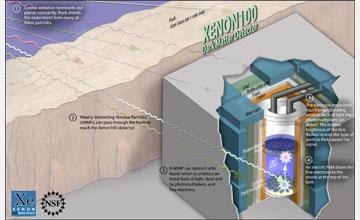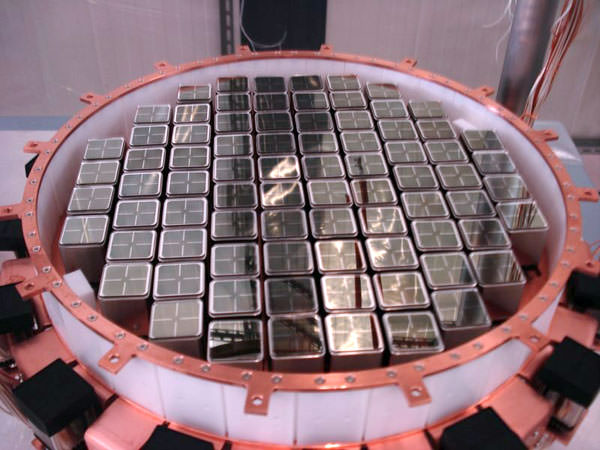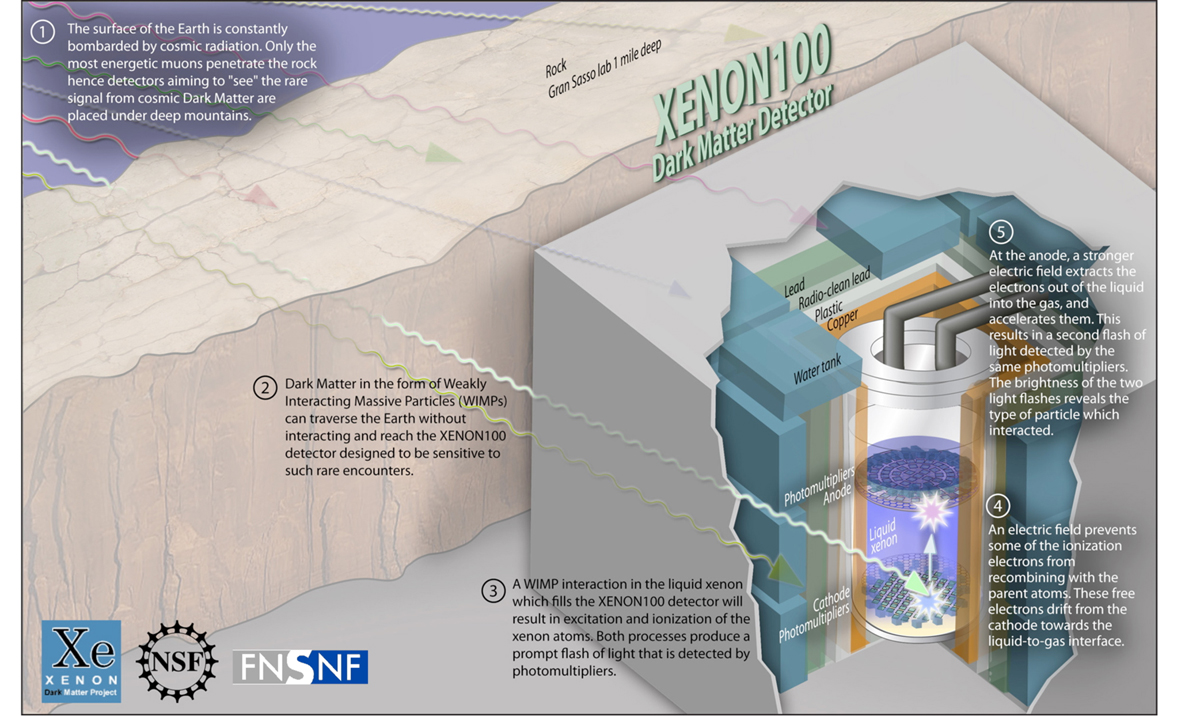National Science Foundation | 2011 Apr 14
Dark matter no-show confronts supersymmetryToday, scientists from the XENON collaboration announced the result from their search for the elusive component of our universe known as dark matter. After analyzing one hundred days of data taken with the XENON100 experiment, they see no evidence for the existence of Weakly Interacting Massive Particles (WIMPs), the leading candidates for the mysterious dark matter. The XENON100 experiment is operated deep underground at the Gran Sasso National Laboratory of the Italian National Institute for Physics (INFN).Collaboration reveals results from 100-day experimentCredit: Zina Deretsky/National Science Foundation/XENON100 Collaboration
While the group observed three candidate events, two had been expected in conjunction with background radiation. This new result translates into the highest sensitivity reported by any dark matter experiment to date, and serves to further constrain the new physics models for particle dark matter, which will help target future WIMP searches. A paper about the results has been submitted to the journal Physical Review Letters and posted to arXiv, the e-print archive hosted by the Cornell University Library(1).
A direct observation of WIMPs would link the largest observed structures in the universe with the world of subatomic particle physics. While no detection can be claimed yet, the level of sensitivity achieved by the XENON100 experiment may allow an actual detection in the near future.
XENON100 is an ultra-sensitive device, with specially designed layers of water, lead, copper and other shielding, to filter out radiation and other sources of energy that could cause a false signal. This is also why the experiment is located beneath a mile of rock and Earth--these materials help shield the detector from cosmic radiation that is constantly bombarding Earth.
The XENON100 detector uses 62 kg of liquid xenon as a WIMP target, and measures the tiny charge and light signals that are expected when rare collisions between WIMPs and xenon atoms take place. Xenon--the same element used to make those ultra-bright car headlights that have a bluish tint--is used in this experiment because it has a large nucleus that WIMPS can collide with. When such a collision occurs, it creates a bluish light and a charge that scientists can detect with highly sensitive cameras positioned at each end of the detector.
Cosmological observations consistently point to a picture of our universe where ordinary matter as we know it makes up only about 4 percent, while new, yet unobserved forms of so-called dark matter and dark energy make up the rest. This is consistent with ideas on small scales too, since attractive extensions of the Standard Model of particle physics suggest that exotic new particles, which are perfect dark matter candidates, exist. This makes Weakly Interacting Massive Particles of interest to both cosmology and particle physics. Thus, the search for WIMPs is well motivated, and a direct detection is a central piece of information that could confirm this new picture of our universe. New data from the 2011 run, and the collaboration's plan to build a much larger experiment with 2500 kg of xenon in the coming years, promise an exciting decade towards the solution of one of nature's most fundamental mysteries.
Nature News | Eugenie Samuel Reich | 2011 Apr 14
New Data from XENON100 Narrows the Possible Range for Dark MatterThe XENON100 experiment has placed the tightest limits yet on the properties of dark matter.
After months of battling radioactive contamination that threatened to swamp its detector, the XENON100 collaboration has managed to place the strongest limits yet on the detection of dark matter. The no-show, announced today at a seminar in Gran Sasso National Laboratory in Italy, places constraints on supersymmetry, the leading alternative to the standard model of particle physics.
Dark matter is thought to make up 83% of the matter in the Universe, and a number of experiments are competing to be the first to detect its rare interactions with ordinary matter. XENON100 looks for proposed dark-matter particles called weakly interacting massive particles (WIMPs) as they pass through the central portion of 161 kilograms of liquid xenon beneath 1.4 kilometres of rock at Gran Sasso. The particles should produce electric charge and light signals as they collide with xenon nuclei.
In a paper published online last night, the XENON100 researchers report three events detected during a 100-day run of the experiment last year that might have been due to dark matter(1). However, as they expected to see between 1.2 and 2.4 background events — interactions mostly caused by a radioactive contaminant in the xenon — their result is statistically negative and therefore rules out the existence of many of the more strongly interacting and heavier WIMPs.
"We were of course hoping to see evidence of dark matter and we didn't, but we did have a very high sensitivity," says particle physicist Laura Baudis of the University of Zurich in Switzerland, and a group leader in the XENON100 collaboration. Baudis notes that contamination was higher than hoped, and higher than in a previous experimental run(2), because of a leak in the experiment. However, she says, it is still much lower than that in many other experiments, and low enough that the group can be confident in its findings.
The new findings significantly constrain supersymmetry, a theory that predicts the existence of a host of particles that physicists are hoping to detect through collisions in the Large Hadron Collider (LHC) at CERN, Europe's particle-physics lab in Geneva, Switzerland. The lightest of the particles predicted by supersymmetry may also be a WIMP.
In their paper, the XENON100 researchers report that their result is the first to cut into the region of heavier WIMPS that is also accessible by the LHC. Baudis says that it also contradicts reports of the lighter WIMPs that the Dark Matter experiment (DAMA) in Gran Sasso, and Coherent Germanium Neutrino Technology (CoGeNT) experiment in the Soudan mine in Minnesota claimed to detect.
WIMP limits
Dan Hooper, a theoretical physicist at Fermilab in Batavia, Illinois, says that he is enthusiastic about the limits the XENON100 collaboration have placed on heavier WIMPs. But he questions whether the detector is sensitive enough to lighter ones to challenge the DAMA and CoGeNT findings. "I'm a little more sceptical about that," he says.
Juan Collar, a cosmologist at the University of Chicago in Illinois, who works on CoGeNT, agrees. He says that a lot rests on the calibration of the XENON100 detector, which he will be looking to study in detail. "Previous attempts by the XENON collaboration to calibrate the response of their detector contained traceable mistakes in methodology," he says(3,4). Only if his analysis confirms the calibration would he be sure that the experiment is in conflict with the DAMA and CoGeNT results.
The previous record ruled out WIMPS that were five times more likely to interact with ordinary matter as the new results, and was set in 2010 by XENON100 and the Cryogenic Dark Matter Search (CDMS), another experiment in the Soudan mine that is looking for WIMPs hitting the nuclei of atoms in germanium crystals.
CDMS member Sunil Golwala of California Institute of Technology in Pasadena, says that XENON100's latest result is "impressive". He adds that the sudden rate of progress — improving constraints by a factor of five in just a year — is typical for this type of experiment, which is able to progress fast until its level of background becomes close to the level of the signal it is looking for. That point seems to have been reached now, so, he says, improving greatly on the current results will require the construction of larger detectors, to give WIMPS a greater mass of detector to collide with and produce a signal. The XENON100 collaboration hopes eventually to scale up to use as much as one tonne of xenon, which will be 100 times more sensitive to potential WIMPS.
Another large-scale xenon experiment expected to come online by the end of this year is the Large Underground Xenon (LUX) detector, which will search for dark matter using 350 kilograms of liquid xenon placed underground in the Sanford Underground Laboratory at Homestake, South Dakota. LUX physicist Rick Gaitskell of Brown University in Rhode Island, is upbeat about XENON100's result. "From our point of view this is very exciting because we're seeing a result from the new generation of xenon detectors that is a significant improvement over any other competing technology," he says, adding that the sensitivity of XENON100 bodes well for LUX's chances of finding dark matter — or ruling it out.
Weizmann Institute of Science | 2011 Apr 14
An International team of scientists in the XENON collaboration, including several from the Weizmann Institute, announced on Thursday the results of their search for the elusive component of our universe known as dark matter(1). This search was conducted with greater sensitivity than ever before. After one hundred days of data collection in the XENON100 experiment, carried out deep underground at the Gran Sasso National Laboratory of the INFN, in Italy, they found no evidence for the existence of Weakly Interacting Massive Particles – or WIMPs – the leading candidates for the mysterious dark matter. The three candidate events they observed were consistent with two they expected to see from background radiation. These new results reveal the highest sensitivity reported as yet by any dark matter experiment, while placing the strongest constraints on new physics models for particles of dark matter. Weizmann Institute professors Eilam Gross, Ehud Duchovni and Amos Breskin, and research student Ofer Vitells, made significant contributions to the findings by introducing a new statistical method that both increases the search sensitivity and enables new discovery.
Any direct observation of WIMP activity would link the largest observed structures in the Universe with the world of subatomic particle physics. While such detection cannot be claimed as yet, the level of sensitivity achieved by the XENON100 experiment could be high enough to allow an actual detection in the near future. What sets XENON100 apart from competing experiments is its significantly lower background radiation, which is 100 times lower, greatly reducing the potential obscuring of any dark matter signal. The XENON100 detector, which uses 62 kg of liquid xenon as its WIMP target, and which measures tiny charges and light signals produced by predicted rare collisions between WIMPs and xenon atoms, continues its search for WIMPs. New data from the 2011 run, as well as the plan to build a much larger experiment in the coming years, promise an exciting decade in the search for the solution to one of nature's most fundamental mysteries.
Cosmological observations consistently point to a picture of our universe in which the ordinary matter we know makes up only 17% of all matter; the rest – 83% – is in an as yet unobserved form – so-called dark matter. This complies with predictions of the smallest scales; necessary extensions of the Standard Model of particle physics suggest that exotic new particles exist, and these are perfect dark matter candidates. Weakly Interacting Massive Particles (WIMPs) are thus implied in both cosmology and particle physics. An additional hint for their existence lies in the fact that the calculated abundance of such particles arising from the Big Bang matches the required amount of dark matter. The search for WIMPs is thus well-founded; a direct detection of such particles would provide the central missing piece needed to confirm this new picture of our Universe.
The properties of dark matter have been addressed through a variety of approaches and methods; these have provided the scientists with indirect hints of what to search for. WIMPs are expected to have a mass comparable to that of atomic nuclei, with a very low probability that they will interact with normal matter. Such particles are thought be distributed in an enormous cloud surrounding the visible disk of the Milky Way. Earth is moving through this cloud, along with the Sun, on its journey around the Galaxy center. This movement results in a 'WIMP wind,' which may occasionally scatter off atomic nuclei in an Earth-bound detector, releasing a tiny amount of energy which can then be detected with ultra-sensitive devices.
In the XENON100 experiment, 62 kg of liquid xenon acts as a WIMP target. The liquid, at a temperature of about -90° C, is contained in a stainless steel cryostat equipped with a cryo-cooler to maintain highly stable operating conditions. The experiment is located in the Gran Sasso Underground Laboratory (LNGS) in Italy where it is shielded from cosmic radiation by 1400 meters of rock. Further shielding from radioactivity in the detector itself and its surroundings is provided by layers of active and passive absorbers surrounding the target. These include 100 kg of active liquid xenon scintillator, 2 tons of ultra-pure copper, 1.6 tons of polyethylene and 34 tons of lead and water. The radio-pure materials used to produce the detector components assure an ultra-low background radiation environment.
Particles interacting within the active liquid xenon space excite and ionize atoms. This results in light emission in the deep ultraviolet. As electrons drift across the liquid xenon, they create a delayed, luminescent signal on the top of the detector, due to the experiment’s strong electric field. Both primary and secondary scintillation light signals are detected via two arrays of photosensors – one located in the liquid xenon at the bottom, and one in the gas above the liquid. The simultaneous measurement of these two light signals enables the researchers to infer both the energy and the spatial coordinates of the particles’ interaction, while providing information on their nature. This analysis of ratio of the two light signals and their precise localization in space is an extremely accurate method of distinguishing WIMP signals from background events.
Many of technologies and methods used in the XENON100 experiment have been built on the research and development efforts of the XENON Dark Matter Search program, which produced, in 2006, the XENON10 prototype. For XENON100, a ten-fold increase in fiducial target mass, combined with 100-fold reduction in background, translates into a substantial improvement in sensitivity to WIMP-nucleon elastic scattering. An extensive calibration using various sources of gammas and neutrons was performed to demonstrate that XENON100 reached its goals for sensitivity and for low background radiation.
Results from a preliminary analysis from 11.2 days worth of data, taken during the experiment’s commissioning phase in October and November 2009, have already set new upper limits on the interaction rate of WIMPs – the world's best for WIMP masses below about 80 times the mass of a proton (Physical Review Letters 105 (2010) 131302(2)).
A new dark matter search was performed between January and June, 2010, and 100 days worth of data from this run have been analyzed. Three candidate events were found within the pre-defined parameters in which the WIMP signal is expected to appear. However, these events, while coming from true particle interactions in the detector, are consistent with predictions of two such events resulting from radioactive backgrounds. Thus evidence for dark matter cannot be claimed, but a new upper limit for the strength of its interaction with normal matter could be calculated. These results represent the best limits to date. They narrow the possibilities open to supersymmetric particle physics theories that predict the nature of dark matter.
XENON100 has achieved the lowest background among all dark matter experiments worldwide (Physical Review D (2011)(5); arXiv:1101.3866(6)). Since the data presented here were collected, the intrinsic background from radioactive krypton in the xenon filling XENON100 has been reduced to an unprecedented low level and the detectors’ performance has been improved as well. Even as new data are being collected in these improved conditions, the scientific team is preparing a next-generation dark-matter search experiment featuring a detector that will contain more than 1000 kg of liquid xenon as a fiducial WIMP target. With further reduction in overall background radiation, XENON1T promises to be a hundred times more sensitive than XENON100.
- Dark Matter Results from 100 Live Days of XENON100 Data - XENON100 Collaboration
- arXiv.org > astro-ph > arXiv:1104.2549 > 13 Apr 2011
Submitted for publication in Physical Review Letters
- arXiv.org > astro-ph > arXiv:1104.2549 > 13 Apr 2011
- First Dark Matter Results from the XENON100 Experiment - XENON100 Collaboration
- Physical Review Letters 105 131302 (20 Sep 2010) DOI: 10.1103/PhysRevLett.105.131302
arXiv.org > astro-ph > arXiv:1005.0380 > 03 May 2010 (v1), 01 Mar 2011 (v3)
- Physical Review Letters 105 131302 (20 Sep 2010) DOI: 10.1103/PhysRevLett.105.131302
- Comments on "First Dark Matter Results from the XENON100 Experiment" - JI Collar, DN McKinsey
- arXiv.org > astro-ph > arXiv:1005.0838 > 05 May 2010 (v1), 12 May 2010 (v3)
- Light WIMP Searches: The Effect of the Uncertainty in Recoil Energy Scale and Quenching Factor - JI Collar
- arXiv.org > astro-ph > arXiv:1010.5187 > 25 Oct 2010
- XENON10/100 dark matter constraints in comparison with CoGeNT and DAMA: Examining the Leff dependence - C Savage et al
- Physical Review D 83 055002 (03 Mar 2011) DOI: 10.1103/PhysRevD.83.055002
- Study of the electromagnetic background in the XENON100 experiment - XENON100 Collaboration
- arXiv.org > astro-ph > arXiv:1101.3866 > 20 Jan 2011 (v1), 26 Mar 2011 (v2)
Scientific American | John Matson | 2011 Apr 14
No Dark Matter Seen by XENON
Discover Blogs | Cosmic Variance | Sean Carroll | 2011 Apr 14
Underground Experiment Fails to Find Dark Matter
Wired Science | John Matson | 2011 Apr 14
XENON100 fails to find dark matter
Science News | Ron Cowen | 2011 Apr 14
No Joy for Dark Matter Detector’s First 100 Days
Universe Today | Nancy Atkinson | 2011 Apr 15


